A summary of a great weekend at the
New England Gathering of War Tax Resisters
Woolman Hill, Deerfield, Massachusetts, November 16-18, 2018
Between 1989 and 1993, hundreds of people flocked to Colrain, Mass., to voice their opposition to war and military spending by supporting the war tax resistance (WTR) of Betsy Corner and Randy Kehler when the IRS seized their home. You can read about them and a synopsis of the house seizure here – and through many other web links.
About 50 people turned up during the reunion weekend to share personal impacts, reflections, analysis, and lessons of the Colrain action. There were also presentations and perspectives on the military budget and the current state of the WTR and the peace movement nationally. It was a packed weekend of wonderful stories, music (thanks Tom Neilson), talk, and we left with mounds of food-for-thought. This blog got way too long, and I think you will see that there will be much more to write about over time.
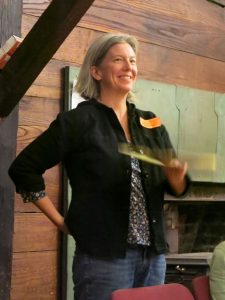
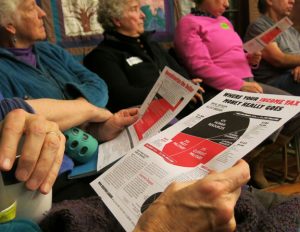 Frida Berrigan, columnist for Waging Nonviolence, among other publications, started the weekend off with a presentation about the ever-bloated military budget, or as weekend organizer Bob Bady likes to call it, “the brontosaurus in the living room that nobody talks about.” The talk was followed by many questions and comments about why the public allows this to go on and our struggle for concrete actions that might catch fire and lead to a dramatic shift in federal priorities.
Frida Berrigan, columnist for Waging Nonviolence, among other publications, started the weekend off with a presentation about the ever-bloated military budget, or as weekend organizer Bob Bady likes to call it, “the brontosaurus in the living room that nobody talks about.” The talk was followed by many questions and comments about why the public allows this to go on and our struggle for concrete actions that might catch fire and lead to a dramatic shift in federal priorities.
Bob Bady was a key organizer behind the Colrain actions that took place under the banner of “It’s wrong to confiscate homes in order to force people to pay for war.” His house had also been seized and auctioned, but the buyer never attempted to take it over. Bob started off the Saturday morning sessions with a timeline from the house seizure in March 1989, through two auctions and sale to a young couple Danny Franklin and Terry Charnesky (now Franklin), to the actual eviction of the Kehler-Corners in December 1991, to when the couple and their baby moved in April 1992, and the resulting vigil and occupation at and around the house. The Colrain action turned into the longest and most remarkable war tax protest in U.S. history. During the 18-month occupation there were 60 arrests (usually for being on the property when ordered off) involving 52 people who spent five days to two weeks in jail. The final arrests were in September 1993 after a court-ordered injunction forced the end of the occupation.
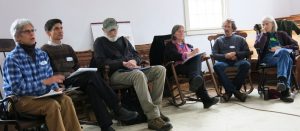 A panel of very-involved Colrain-area participants talked about what the action meant to them at the time and how they look back on it now. Here are some notes and quotes to match the photo (left to right):
A panel of very-involved Colrain-area participants talked about what the action meant to them at the time and how they look back on it now. Here are some notes and quotes to match the photo (left to right):
Betsy Williams talked about WTR as mostly being an isolated and private protest, so translating those principles to a “very public and group action was profound.” “Many other political actions pale to this,” she said.
Aaron Falbel was impressed with this couple who were willing to risk their house for their beliefs, but was also conflicted about the Gandhian philosophy of “submission to the penalty” versus saving the home for the Kehler-Corner family. After the Franklins moved in and seeing that they felt harassed by the occupation, Aaron thinks “our principled acts needed to be tempered by a concern for human relationships and community, even with — probably especially with — people with whom we disagreed and were in conflict.”
D.O. was inspired by the call to Colrain and by history to initiate the Daniel Shays Nonviolent Bioregional Liberation Frente affinity group, which welcomed new participants with fife and drum, tri-corner hats and colonial costumes. He found the action “inspiring, unifying, joyous and affirming” and wrote a poem that places it in the long arch of history.
Cheryl Fox keeps coming back to “the importance of community” that developed during the action. “Paradox” also captured her interest in listening to others where “this might be true but the opposite might be true also.” Understanding diversity and including different voices is necessary to community.
Alan Ladd was a friend and neighbor on the land trust across the road from the Kehler-Corner house. The land trust was caught in a complicated struggle with the government’s sale of the house. He called the action “romantic before the shit hit the fan” and found in the long run that the fight left the land trust “weakened and vulnerable.” He has really learned how fallible human memory is, and we need to be aware that “what we carry forward is different from what other people who experience the same exact thing carry forward.”
Betsy Corner says when she talks about things that were hard for her at the time, she tries to keep in perspective that many things in life are hard. She did not grow up with conflict and finding herself in the middle of it was very hard and how it affected their family, including her parents who were worried about what would happen. Their daughter Lillian was in middle school when the house was seized, a hard age for a child to handle change. She had to endure things like waiting for the school bus with “all these weird people” outside her house. Betsy is ever grateful for the supportive community then and now, and is often surprised by the people who come up and express their respect 5, 10, 20 years later.
Daughter Lillian spoke after the panel for the first time, reflecting on how it all felt to her. “I was there but not there,” she said. Her parents tried to keep things as normal as possible, and she didn’t talk about what was happening with her friends. One of her worst memories is of visiting her father in the Hampshire County Jail, where he was held for two months on contempt of court for refusing to leave the home. Today Lillian is experimenting with how to tell her two young children about this significant time in her family’s lives.
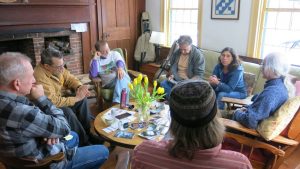 During small group sessions each of us could talk about our own participation at Colrain, the personal impact, and what we learned from it.
During small group sessions each of us could talk about our own participation at Colrain, the personal impact, and what we learned from it.
The afternoon was spent with a deeper analysis. Those who participated most closely in decision-making and strategy through the Occupation Support Committee reflected on the goals and process, where goals were met, adjustments made, or when actions failed to meet goals and principles. Perhaps everyone agreed that the support action up to the point where the Franklins moved into the house was pretty unified. After they moved in, meetings and strategizing were more difficult. Some supporters drifted away; there were times when the vigil was faced with violent acts and threats of violence; and there was conflict within the support community about whether the action was too much against the family and losing focus on losing the house as a consequence of refusing to pay for war. But the core group stuck together through all their differences. As Aaron Falbel said, “I learned that nonviolent people could disagree.”
As readers of this blog might imagine, this is far too much to write up in one post, and the session on lessons from the action will have to be a future post.
However, this post cannot end without giving some description of the most moving session of the weekend. For most of us who went up to the action one or two times, followed it from afar, and/or “saw the movie” (An Act of Conscience), we knew that the land trust finally settled with the Franklins. They moved out at the end of 1994, and the land trust took control over the house. Randy and Betsy moved into a home with Betsy’s mother on land trust property where they live today.
What many of us did not know was that a relationship had been established with Terry Franklin that would develop over the following years as some of the participants in the action saw her in town or found their children going to the same school. When WTR support committee participant Mary Link heard that the Franklin family was in a difficult way, she and others stepped up to help out. Terry wrote a thank you note and said, “When I think about Colrain, I kept wondering why I had to go through that, and now I know, because a harder time would come and I was going to need you.”
Terry said that when she was asked to come to the weekend she said “yes” without hesitation. She has run into Betsy over the years and found that Betsy “never treated me as ‘the bad person who bought the house’.” Terry describes herself as a social person who loves to talk, so even when they had moved into the house and the vigil was outside, she did talk to the folks she saw regularly. Then the lawyers got involved, and she was told not to talk to them anymore. She thinks that it might have been possible that they could have worked something out over time, but the lawyers got in the way. Randy mentioned the “delightful visit” with Terry and her mother when they first came to see the house after the sale. He saw her display a lot of courage throughout the action — and in coming to this weekend.
Terry wanted to come and apologize for some of the things she said at the time, though no one in the room seemed to think any apology was needed. Asked what she got out of that time she says tentatively, “I don’t know. A good story I guess.” Mostly she has tried not to think about Colrain and the stress of seeing people outside the house all the time bringing turmoil in her own house at times. One thing that sticks in her mind is a sign that was left in the garage at the Colrain house. It said “Bidding on this house could be unsettling.” She thought once they moved in “that would be that” and the vigil would end. She also believed the police and government would make the vigil go away, but instead she learned “that public officials are in for themselves,” and they washed their hands of the whole matter after the sale.
“It’s not like I disagreed with anything you guys were saying, I just felt you were taking it out on the wrong person because I wasn’t the one who was taking your money. I wasn’t the one giving it to anybody you didn’t want it to go to.” Things could have been done better “on our side too,” she said. But one thing she was secure about: no one would ever break into her house “because you all were always out there!”
There was much laughter in this session, along with tears, gratitude, and deeper reflection all around.
The Sunday panel of WTRs and organizers Bill Ramsey, Ruth Benn, Larry Rosenwald, and Joanne Sheehan gave perspectives on “the impacts Colrain might have had on the national WTR movement and the current state of that movement.” We covered how it inspired us and also some of the negative impacts for potential resisters of the possible bad consequences. The background question for much of the weekend was “why didn’t this action create the big movement we thought it would.” It was a powerful and sustained action with broad support. but many other factors affect movement-building. Larry spoke about WTR as an individual act of conscience, we “do what we are led to do” but that does not create a movement. WTR lacks a shared discipline, with maybe too much focus on “conscience” and too much focus on “war” with so many other movements highlighting other reason to refuse taxes. I mentioned hearing stories about and knowing that there are way more conscientious tax resisters than we know about, but that it seems impossible to capture that energy into a movement. Joanne talked about the many movements that are active now, but she finds that those activists talk about nonviolence very differently than we do. They don’t look at the principles and lifestyle, so much as the tactics. We see the intersection of issues but to really make the connections with other activists we have to build relationships. We have to work with people side-by-side. We see the relationships that came out of the close work of the Colrain action and how relationship-building is critical for the long haul. More discussion involved how our community can really create a national dialogue about military spending because, as Bob Bady said, “money so connects all the issues.”
If you’ve read this far you can probably see that there is a lot to say about this weekend. There are voice recordings that should become available before long. Having listened to some of these sessions again, I think they will be well worth listening to for those of you who were not there in person. And others will write about the things that stood out to them. Hopefully it will add up to continued dialogue — and then maybe more unified actions — to carry on our war tax resistance and to build that movement to cut military spending and use that money for all the desperate needs we see around us and hear about every day.
— Post and photos by Ruth Benn

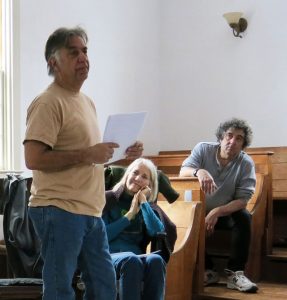
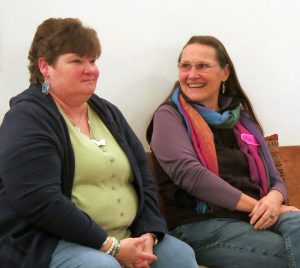
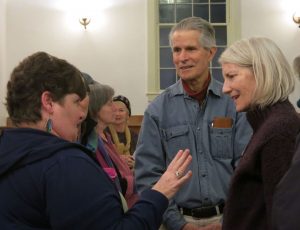
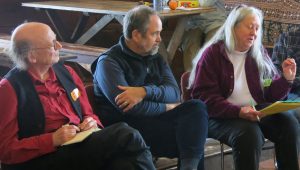

Good summary, Ruth. It was a really amazing weekend. I’ve been thinking about what was said ever since. An addition I would make was Becky Pierce’s comment that we need to emphasize that war tax resistance is a tactic of resistance. While there was a lot of discussion over the weekend of the commitment to nonviolence at the Colrain action, and how many are inspired by the pacifists who do not pay for war, centering resistance is important as we connect with people dealing with so many issues. How can we support their resistance with our tactic of resistance.
Very nice report and I’m sorry to have missed it. I think Terry’s presence and the discussion with her was clearly a remarkable part of the weekend.
A great summary, Ruth. Thanks for it and for all your work.
I am so sorry that I was not able to attend the reunion, but I live in Kenya which is quite far away. Thanks so much, Ruth, for the notes. I hope others will add.
When the first vigils occurred, my daughter, Joy, just finished high school, and my son, Tommy, had one more year of high school. We wanted to do what we called QFT (Quality Family Time) and I asked the kids if they would be interested in spending a week at the Colrain vigil. I was pleasantly surprised that they both liked the idea. The reason, I think, was because they new Randy and liked him. We spent the week there together. Perhaps one of the main benefits for them was to meet Juanita and Wally Nelson.
My favorite remembrance was when Tommy and I were doing the night/day break vigil together and the skunk came wandering by as it did every night. Tommy absolutely froze in horror but the skunk didn’t seem to even notice us and went on its way.
Even tho all above was plenty to enjoy, I had an additional delight running into two of my favorite musician heroes, Cheryl Fox and Court Dorsey! The piano is mightier than the sword!
That’s a terrific summary, Ruth – thanks so much. As the days pass since the gathering, I’m finding my impressions sorthing themselves into two groups. The first group of impressions has to do with the past, with the wisdom and clarity that we gathered about what we did then. There was much joy in that, the joy of clarity and unguarded reflection, of reconciliation. There was also much shared melancholy, especially in the session in which we recalled the names of those who were part of the action and have died – have gone on, as they say in Yiddish, to the true world. The second group of impressions has to do with the present and future, and there, for me at least, joy isn’t the dominant emotion, and clarity isn’t granted us. I at any rate didn’t leave with a clear sense of how to proceed, of what the future of war tax resistance is likely to be, to what extent it’s likely to have a future. Joy and sorrow, clarity and deep uncertainty.
I’m surprised that there was no apparent discussion of the Constructive Program that emerged as a sister element of the Colrain Action, nor of the role such creative initiatives can play in sustaining a movement that becomes dissipated when there is nothing immediate to resist through an Obstructive Program.
Building Our Swords Into Plowshares was the “other side” of the Colrain Action, and included the community-building elements of common vision, volunteer labor and cooperative institutions. It could, perhaps, have been sustained in a way that focused resistance actions cannot, and helped sustain the resistance movement during times of inactivity.
Gandhi believed that civil disobedience was but an “aid” to constructive program, which was the heart and soul of his political philosophy and life work. In fact, his successful Gramdan (or village land gift) movement evolved into the Community Land Trust movement, of which the Valley Community Land Trust in Colrain – where Randy & Betsy’s house resided – was a part.
Thanks Ruth and all for the comments. I thought your report on the weekend and the photos were great. After reading through your comments twice and Larry’s presentation from the panel on Sunday a.m. as well, I only have a couple of comments. I was excited to meet some of the key Colrain players for the first time and was astounded to be in the presence of so many WTR “rock stars”, people of conscience whom I have considered to be modern day heros for a long time. I would include Terry Franklin as a heroine as well as her very attendance at this weekend was nothing short of heroic given her position on “the other side” as one that purchased the house. Very moving to witness real time reconciliation in the Quaker meeting house at Woolman Hill.Terry’s response about her perception of the actions being non-violent gave me much food for thought: “Physically yes; emotionally no”. I’d love to see on-going dialogue about moving WTR into the future as a result of these discussions/this weekend.
Not surprised to see how well Ruth has captured the essence of the weekend. I’m still looking back at the integrity and depth of feelings and experience that were expressed by all present. Also grateful to those who made it possible, especially Bob Bady’s initiation and thorough organizing along with Mary Link, Aaron Falbel, Cheryl Fox, Court Dorsey and Margaret Cooley’s work. Not to mention the healthy comfort food we tend to take for granted from Joanne and Rick!
There was some discussion of the constructive program, in my remarks and in some of the comments at sessions I was present for, including the session with Terry.
I’m grateful to read these vignettes, these sagas of courage, of events and a time that have meant so much to me!